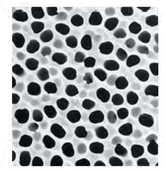Nanotube membranes offer possibility of cheaper desalination
Advertisement
Researchers at Lawrence Livermore National Laboratory have created a membrane made of carbon nanotubes and silicon that may offer, among many possible applications, a less expensive desalinization. The nanotubes are hollow and more than 50,000 times thinner than a human hair. Billions of these tubes act as the pores in the membrane. The super smooth inside of the nanotubes allow liquids and gases to rapidly flow through, while the tiny pore size can block larger molecules. This previously unobserved phenomenon opens a vast array of possible applications.
The team was able to measure flows of liquids and gases by making a membrane on a silicon chip with carbon nanotube pores making up the holes of the membrane. The membrane is created by filling the gaps between aligned carbon nanotubes with a ceramic matrix material. The pores are so small that only six water molecules could fit across their diameter.
"The gas and water flows that we measured are 100 to 10,000 times faster than what classical models predict," said Olgica Bakajin, the Livermore scientist who led the research. "This is like having a garden hose that can deliver as much water in the same amount of time as fire hose that is ten times larger."
Simulations of gas and water transport through carbon nanotubes predict that each should flow rapidly. Gas molecules should bounce off its atomically smooth surface like billiard balls. Water molecules should slide through either because of the "slipperiness" of the carbon nanotube surface or due to molecular ordering induced by spatial confinement. The experiments performed by the LLNL team demonstrated these predicted rapid flows of gas and water through carbon nanotubes, but further research is needed to determine the exact transport mechanisms.
Another potential application for the membranes is in gas separation. The high gas permeability and its affinity to hydrocarbons may allow for lower-energy, industrial-gas separations.
Other news from the department science
These products might interest you

Get the chemical industry in your inbox
By submitting this form you agree that LUMITOS AG will send you the newsletter(s) selected above by email. Your data will not be passed on to third parties. Your data will be stored and processed in accordance with our data protection regulations. LUMITOS may contact you by email for the purpose of advertising or market and opinion surveys. You can revoke your consent at any time without giving reasons to LUMITOS AG, Ernst-Augustin-Str. 2, 12489 Berlin, Germany or by e-mail at revoke@lumitos.com with effect for the future. In addition, each email contains a link to unsubscribe from the corresponding newsletter.






























































